A Tale Of Two Economies: Singapore And Cuba
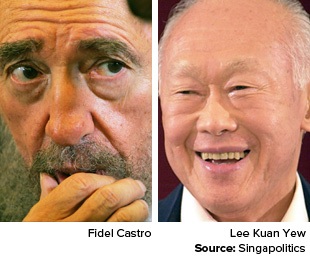 It would be nearly impossible to find two world leaders in living memory whose influence is more inextricably linked to the countries they presided over than Cuba’s Fidel Castro and Singapore’s Lee Kuan Yew, who passed away this Monday at the age of 91.
It would be nearly impossible to find two world leaders in living memory whose influence is more inextricably linked to the countries they presided over than Cuba’s Fidel Castro and Singapore’s Lee Kuan Yew, who passed away this Monday at the age of 91.
You might find this hard to believe now, but in 1959—the year both leaders assumed power—Cuba was a much wealthier nation than Singapore. Whereas Singapore was little more than a sleepy former colonial trading and naval outpost with very few natural resources, Cuba enjoyed a thriving tourism industry and was rich in tobacco, sugar and coffee.
Fast forward about 55 years, and things couldn’t have reversed more dramatically, as you can see in the images below.
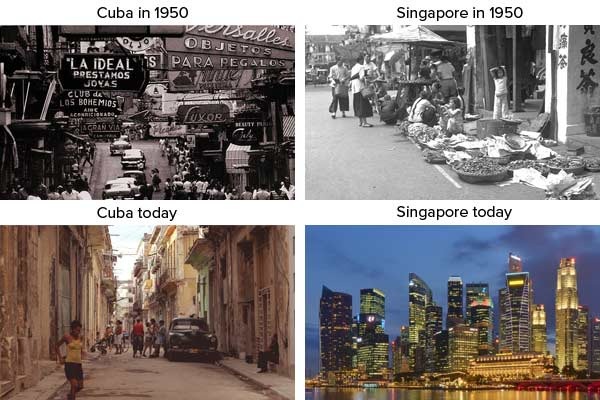
The ever-widening divergence between the two nations serves as a textbook case study of a) the economic atrophy that’s indicative of Soviet-style communism, and b) the sky-is-the-limit prosperity that comes with the sort of American-style free market capitalism Lee introduced to Singapore.
Sound fiscal policy, a strong emphasis on free trade and competitive tax rates have transformed the Southeast Asian city-state from an impoverished third world country into a bustling metropolis and global financial hub that today rivals New York City, London and Switzerland. Between 1965 and 1990—the year he stepped down as prime minister—Lee grew Singapore’s per capita GDP a massive 2,800 percent, from $500 to $14,500.
Since then, its per capita GDP based on purchasing power parity (PPP) has caught up with and zoomed past America’s.
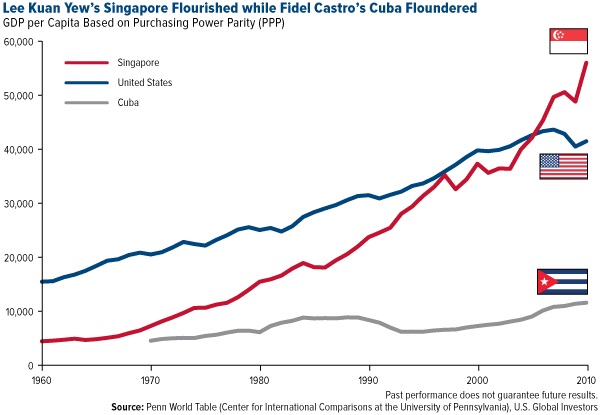
Under Castro and his brother Raúl’s control, Cuba’s once-promising economy has deteriorated, private enterprise has all but been abolished and the poverty rate stands at 26 percent. According to the CIA’s World Factbook, “the average Cuban’s standard of living remains at a lower level than before the collapse of the Soviet Union.” Its government is currently facing bankruptcy. And among 11.3 million of Cuba’s inhabitants, only 5 million—less than 45 percent of the population—participate in the labor force.
Compare that to Singapore: Even though the island is home to a mere 5.4 million people, its labor force hovers above 3.4 million.
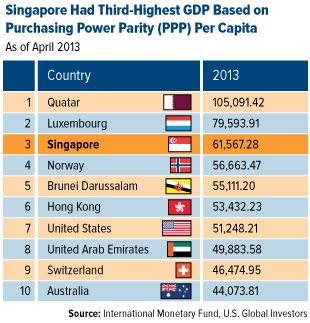 Because of the free-market policies that Lee implemented, Singapore is ranked first in the world on the World Bank Group’s Ease of Doing Business list and, for the fourth consecutive year, ranked second on the World Economic Forum’s Global Competitiveness Report. The Heritage Foundation ranks the nation second on its 2015 Index of Economic Freedom, writing:
Because of the free-market policies that Lee implemented, Singapore is ranked first in the world on the World Bank Group’s Ease of Doing Business list and, for the fourth consecutive year, ranked second on the World Economic Forum’s Global Competitiveness Report. The Heritage Foundation ranks the nation second on its 2015 Index of Economic Freedom, writing:
Sustained efforts to build a world-class financial center and further open its market to global commerce have led to advances in… economic freedoms, including financial freedom and investment freedom.
Cuba, meanwhile, comes in at number 177 on the Heritage Foundation’s list and is the “least free of 29 countries in the South and Central America/Caribbean region.” The Caribbean island-state doesn’t rank at all on the World Bank Group’s list, which includes 189 world economies.
Many successful international businesses have emerged and thrived in the Singapore that Lee created, the most notable being Singapore Airlines. Founded in 1947, the carrier has ascended to become one of the most profitable companies in the world. It’s been recognized as the world’s best airline countless times by dozens of groups and publications. Recently it appeared on Fortune’s Most Admired Companies list.
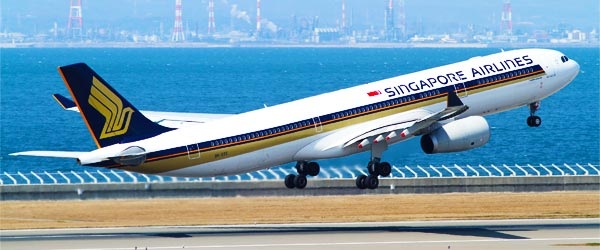
Xian Liang, portfolio manager of our China Region Fund (USCOX), notes that Lee’s key legacy is an emphasis on pragmatism and adaptability.
“Lee was a great visionary indeed,” Xian says. “He achieved wonders, fast-tracking Singapore’s GDP growth to U.S. levels.”
We at U.S. Global Investors honor the memory of Lee Kuan Yew, founder of modern-day Singapore. He showed the world that when a country chooses to open its markets and foster a friendly business environment, strength and prosperity follow. Even on the other side of the globe, the American Dream lives on.
********
Please consider carefully a fund’s investment objectives, risks, charges and expenses. For this and other important information, obtain a fund prospectus by visiting www.usfunds.com or by calling 1-800-US-FUNDS (1-800-873-8637). Read it carefully before investing. Distributed by U.S. Global Brokerage, Inc.
Foreign and emerging market investing involves special risks such as currency fluctuation and less public disclosure, as well as economic and political risk. By investing in a specific geographic region, a regional fund’s returns and share price may be more volatile than those of a less concentrated portfolio.
The Global Competitiveness Index, developed for the World Economic Forum, is used to assess competitiveness of nations. The Index is made up of over 113 variables, organized into 12 pillars, with each pillar representing an area considered as an important determinant of competitiveness: institutions, infrastructure, macroeconomic stability, health and primary education, higher education and training, goods market efficiency, labor market efficiency, financial market sophistication, technological readiness, market size, business sophistication and innovation.
The Ease of Doing Business Index is an index created by the World Bank Group. Higher rankings (a low numerical value) indicate better, usually simpler, regulations for businesses and stronger protections of property rights.
The Index of Economic Freedom is an annual index and ranking created by The Heritage Foundation and The Wall Street Journal in 1995 to measure the degree of economic freedom in the world's nations.
Fund portfolios are actively managed, and holdings may change daily. Holdings are reported as of the most recent quarter-end. Holdings in the China Region Fund as a percentage of net assets as of 12/31/2014: Singapore Airlines 0.00%.
All opinions expressed and data provided are subject to change without notice. Some of these opinions may not be appropriate to every investor. By clicking the link(s) above, you will be directed to a third-party website(s). U.S. Global Investors does not endorse all information supplied by this/these website(s) and is not responsible for its/their
You might find this hard to believe now, but in 1959—the year both leaders assumed power—Cuba was a much wealthier nation than Singapore. Whereas Singapore was little more than a sleepy former colonial trading and naval outpost with very few natural resources, Cuba enjoyed a thriving tourism industry and was rich in tobacco, sugar and coffee.
Fast forward about 55 years, and things couldn’t have reversed more dramatically, as you can see in the images below.

The ever-widening divergence between the two nations serves as a textbook case study of a) the economic atrophy that’s indicative of Soviet-style communism, and b) the sky-is-the-limit prosperity that comes with the sort of American-style free market capitalism Lee introduced to Singapore.
Sound fiscal policy, a strong emphasis on free trade and competitive tax rates have transformed the Southeast Asian city-state from an impoverished third world country into a bustling metropolis and global financial hub that today rivals New York City, London and Switzerland. Between 1965 and 1990—the year he stepped down as prime minister—Lee grew Singapore’s per capita GDP a massive 2,800 percent, from $500 to $14,500.
Since then, its per capita GDP based on purchasing power parity (PPP) has caught up with and zoomed past America’s.

Under Castro and his brother Raúl’s control, Cuba’s once-promising economy has deteriorated, private enterprise has all but been abolished and the poverty rate stands at 26 percent. According to the CIA’s World Factbook, “the average Cuban’s standard of living remains at a lower level than before the collapse of the Soviet Union.” Its government is currently facing bankruptcy. And among 11.3 million of Cuba’s inhabitants, only 5 million—less than 45 percent of the population—participate in the labor force.
Compare that to Singapore: Even though the island is home to a mere 5.4 million people, its labor force hovers above 3.4 million.
 Because of the free-market policies that Lee implemented, Singapore is ranked first in the world on the World Bank Group’s Ease of Doing Business list and, for the fourth consecutive year, ranked second on the World Economic Forum’s Global Competitiveness Report. The Heritage Foundation ranks the nation second on its 2015 Index of Economic Freedom, writing:
Because of the free-market policies that Lee implemented, Singapore is ranked first in the world on the World Bank Group’s Ease of Doing Business list and, for the fourth consecutive year, ranked second on the World Economic Forum’s Global Competitiveness Report. The Heritage Foundation ranks the nation second on its 2015 Index of Economic Freedom, writing:
Sustained efforts to build a world-class financial center and further open its market to global commerce have led to advances in… economic freedoms, including financial freedom and investment freedom.
Cuba, meanwhile, comes in at number 177 on the Heritage Foundation’s list and is the “least free of 29 countries in the South and Central America/Caribbean region.” The Caribbean island-state doesn’t rank at all on the World Bank Group’s list, which includes 189 world economies.
Many successful international businesses have emerged and thrived in the Singapore that Lee created, the most notable being Singapore Airlines. Founded in 1947, the carrier has ascended to become one of the most profitable companies in the world. It’s been recognized as the world’s best airline countless times by dozens of groups and publications. Recently it appeared on Fortune’s Most Admired Companies list.

Xian Liang, portfolio manager of our China Region Fund (USCOX), notes that Lee’s key legacy is an emphasis on pragmatism and adaptability.
“Lee was a great visionary indeed,” Xian says. “He achieved wonders, fast-tracking Singapore’s GDP growth to U.S. levels.”
We at U.S. Global Investors honor the memory of Lee Kuan Yew, founder of modern-day Singapore. He showed the world that when a country chooses to open its markets and foster a friendly business environment, strength and prosperity follow. Even on the other side of the globe, the American Dream lives on.
********
Please consider carefully a fund’s investment objectives, risks, charges and expenses. For this and other important information, obtain a fund prospectus by visiting www.usfunds.com or by calling 1-800-US-FUNDS (1-800-873-8637). Read it carefully before investing. Distributed by U.S. Global Brokerage, Inc.
Foreign and emerging market investing involves special risks such as currency fluctuation and less public disclosure, as well as economic and political risk. By investing in a specific geographic region, a regional fund’s returns and share price may be more volatile than those of a less concentrated portfolio.
The Global Competitiveness Index, developed for the World Economic Forum, is used to assess competitiveness of nations. The Index is made up of over 113 variables, organized into 12 pillars, with each pillar representing an area considered as an important determinant of competitiveness: institutions, infrastructure, macroeconomic stability, health and primary education, higher education and training, goods market efficiency, labor market efficiency, financial market sophistication, technological readiness, market size, business sophistication and innovation.
The Ease of Doing Business Index is an index created by the World Bank Group. Higher rankings (a low numerical value) indicate better, usually simpler, regulations for businesses and stronger protections of property rights.
The Index of Economic Freedom is an annual index and ranking created by The Heritage Foundation and The Wall Street Journal in 1995 to measure the degree of economic freedom in the world's nations.
Fund portfolios are actively managed, and holdings may change daily. Holdings are reported as of the most recent quarter-end. Holdings in the China Region Fund as a percentage of net assets as of 12/31/2014: Singapore Airlines 0.00%.
All opinions expressed and data provided are subject to change without notice. Some of these opinions may not be appropriate to every investor. By clicking the link(s) above, you will be directed to a third-party website(s). U.S. Global Investors does not endorse all information supplied by this/these website(s) and is not responsible for its/their






 Frank Holmes is the CEO and Chief Investment Officer of U.S. Global Investors. Mr. Holmes purchased a controlling interest in U.S. Global Investors in 1989 and became the firm’s chief investment officer in 1999. Under his guidance, the company’s funds have received numerous awards and honors including more than two dozen Lipper Fund Awards and certificates. In 2006, Mr. Holmes was selected mining fund manager of the year by the Mining Journal. He is also the co-author of “The Goldwatcher: Demystifying Gold Investing.” Mr. Holmes is engaged in a number of international philanthropies. He is a member of the President’s Circle and on the investment committee of the International Crisis Group, which works to resolve conflict around the world. He is also an advisor to the William J. Clinton Foundation on sustainable development in countries with resource-based economies. Mr. Holmes is a native of Toronto and is a graduate of the University of Western Ontario with a bachelor’s degree in economics. He is a former president and chairman of the Toronto Society of the Investment Dealers Association. Mr. Holmes is a much-sought-after keynote speaker at national and international investment conferences. He is also a regular commentator on the financial television networks CNBC, Bloomberg and Fox Business, and has been profiled by Fortune, Barron’s, The Financial Times and other publications. Visit the U.S. Global Investors website at
Frank Holmes is the CEO and Chief Investment Officer of U.S. Global Investors. Mr. Holmes purchased a controlling interest in U.S. Global Investors in 1989 and became the firm’s chief investment officer in 1999. Under his guidance, the company’s funds have received numerous awards and honors including more than two dozen Lipper Fund Awards and certificates. In 2006, Mr. Holmes was selected mining fund manager of the year by the Mining Journal. He is also the co-author of “The Goldwatcher: Demystifying Gold Investing.” Mr. Holmes is engaged in a number of international philanthropies. He is a member of the President’s Circle and on the investment committee of the International Crisis Group, which works to resolve conflict around the world. He is also an advisor to the William J. Clinton Foundation on sustainable development in countries with resource-based economies. Mr. Holmes is a native of Toronto and is a graduate of the University of Western Ontario with a bachelor’s degree in economics. He is a former president and chairman of the Toronto Society of the Investment Dealers Association. Mr. Holmes is a much-sought-after keynote speaker at national and international investment conferences. He is also a regular commentator on the financial television networks CNBC, Bloomberg and Fox Business, and has been profiled by Fortune, Barron’s, The Financial Times and other publications. Visit the U.S. Global Investors website at 










